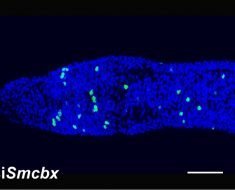People with a form of heart disease called cardiomyopathy have abnormally short telomeres in heart muscle cells responsible for contraction, according to a new study by researchers at the Stanford University School of Medicine.
A telomere is a DNA sequence that serves as a protective cap on the ends of chromosomes.
The finding dovetails with a previous study showing that people with Duchenne muscular dystrophy, a genetic muscle-wasting disease, also have short telomeres in their heart muscle cells, or cardiomyocytes. These patients often die at an early age from heart failure.
Although it’s not yet known whether the stunted telomeres directly affect the function of the cardiomyocytes or arise as a result of heart failure, the finding opens the door to an intriguing line of research and drug discovery. It also may one day allow researchers and clinicians to identify people at risk for heart failure due to cardiomyopathy.
“The shortening of telomeres in cardiomyocytes appears to be a reliable hallmark of cardiac failures that arise due to genetic defects, and it’s very specific to cells that require the missing contractile proteins such as dystrophin, troponin T or myosin heavy chain, among others,” said Helen Blau, Ph.D., professor of microbiology and immunology and member of the Stanford Cardiovascular Institute.
Blau, the Donald E. and Delia B. Baxter Foundation Professor and director of the Baxter Laboratory for Stem Cell Biology, is the senior author of the study, which will be published online Aug. 27 in Proceedings of the National Academy of Sciences. Alex Chang, Ph.D., an instructor of cardiovascular medicine and of microbiology and immunology, is the lead author.
Shortening with cell division
In most cells, telomeres naturally shorten each time the cell divides. But cardiomyocytes divide infrequently, and their telomere lengths remain relatively stable throughout one’s life.
In humans, Duchenne muscular dystrophy, which is caused by a mutation in the dystrophin gene, is characterized by progressive muscle weakness and eventual death due to cardiac complications. In earlier work, Blau and her colleagues observed that although mice with the corresponding mutation in dystrophin displayed the muscle wasting symptoms, their hearts functioned normally. The researchers realized that a key difference between humans and mice is the length of each species’ telomeres: Human telomeres are relatively short at 5-15 kilobases, but mice have telomeres approaching 40 kilobases. When the investigators introduced a second mutation in the mice that reduced telomere length to more closely match that of humans, the animals began to display the typical symptoms of the disease, including heart failure.
A subsequent study in the Blau lab found that, in mice, telomere shortening triggered a DNA-damage response that compromised the function of the cells’ energy generators, or mitochondria. As a result, cardiomyocytes were unable to efficiently pump blood throughout the body.
“Because we found in a previous study that cardiomyocytes from boys who had died of Duchenne muscular dystrophy had telomeres that were about 50 percent shorter than those from individuals without the disease,” Blau said, “we wondered whether people with other genetic heart conditions, such as cardiomyopathies, might also have cardiomyocytes with abnormally shortened telomeres.” Blau and Chang collaborated with several other members of Stanford’s Cardiovascular Institute to investigate the question.
A cardiomyopathy is a condition in which the heart is unusually large, thickened or stiff. This affects its ability to pump blood effectively. One out of every 500-2,500 people worldwide is affected, and cardiomyopathies are a leading cause for heart transplantation. Dilated cardiomyopathy occurs when the left ventricle is enlarged, while hypertrophic cardiomyopathy is caused by a thickening of the heart muscle.
Chang compared the telomere length in cardiomyocytes from 11 patients with dilated or hypertrophic cardiomyopathy due to genetic mutations with nine people who had died from causes unrelated to heart disease. He found that telomeres from the cardiomyopathy patients were about 25-40 percent shorter than those of the control subjects. In contrast, the telomere length in nonbeating heart cells of the blood vessels did not vary significantly between the two groups.
Chang saw similar results in cardiomyocytes generated from induced pluripotent stem cells: Those generated from people with cardiomyopathies had significantly shorter telomeres than those generated from unaffected relatives.
“Within 20 days we could see the telomere shortening happening in the laboratory-grown cardiomyocytes from diseased patients, suggesting this is a cell-intrinsic property,” Blau said.
The ability to use iPS cell technology to generate affected cardiomyocytes also means that it should be possible to quickly and easily test for compounds or drugs that interfere with the telomere shortening with a view to finding drugs to abrogate the disease in humans, the researchers believe.
Source: Read Full Article





